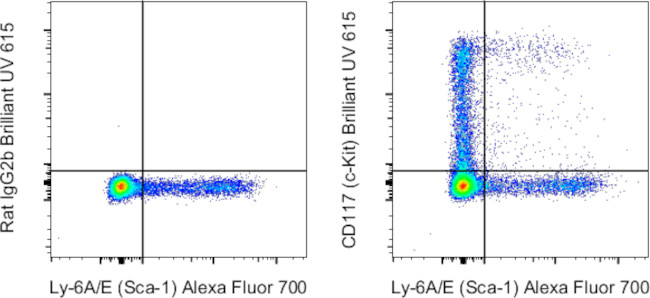Search Thermo Fisher Scientific
Invitrogen
CD117 (c-Kit) Monoclonal Antibody (2B8), Brilliant Ultra Violet™ 615, eBioscience™
FIGURE: 1 / 1
CD117 (c-Kit) Antibody (366-1171-82) in Flow

Product Details
366-1171-82
Species Reactivity
Host/Isotype
Recommended Isotype Control
Class
Type
Clone
Conjugate
Excitation/Emission Max
Form
Concentration
Purification
Storage buffer
Contains
Storage conditions
Shipping conditions
RRID
Product Specific Information
Description: The 2B8 monoclonal antibody reacts with mouse CD117, also known as c-Kit receptor, Steel factor receptor, and stem cell factor receptor. A member of the tyrosine kinase receptor family, this 145-kDa molecule is expressed by a majority of hematopoietic progenitor cells characterized in the mouse bone marrow as a small subset of cells positive for Sca-1 and Thy1 (Thy1 low) and negative for lineage markers. The interaction of the mouse c-Kit receptor and steel factor promotes the proliferation and differentiation of hematopoietic progenitor cells. CD117 is also expressed by mast cells and plays a role in signaling and activation of these cells.
Applications Reported: This 2B8 antibody has been reported for use in flow cytometric analysis.
Applications Tested: This 2B8 antibody has been tested by flow cytometric analysis of mouse bone marrow cells. This may be used at less than or equal to 0.5 µg per test. A test is defined as the amount (µg) of antibody that will stain a cell sample in a final volume of 100 µL. Cell number should be determined empirically but can range from 10^5 to 10^8 cells/test. It is recommended that the antibody be carefully titrated for optimal performance in the assay of interest.
Brilliant Ultra Violet™ 615 (BUV615) is a tandem dye that emits at 615 nm and is intended for use on cytometers equipped with an ultraviolet (355 nm) laser. Please make sure that your instrument is capable of detecting this fluorochrome.
When using two or more Super Bright, Brilliant Violet™, Brilliant Ultra Violet™, or other polymer dye-conjugated antibodies in a staining panel, it is recommended to use Super Bright Complete Staining Buffer (Product # SB-4401-42) or Brilliant Stain Buffer™ (Product # 00-4409-75) to minimize any non-specific polymer interactions. Please refer to the datasheet for Super Bright Staining Buffer or Brilliant Stain Buffer for more information.
Light sensitivity: This tandem dye is sensitive to photo-induced oxidation. Please protect this vial and stained samples from light.
Fixation: Samples can be stored in IC Fixation Buffer (Product # 00-8222-49) (100 µL of cell sample + 100 µL of IC Fixation Buffer) or 1-step Fix/Lyse Solution (Product # 00-5333-54) for up to 3 days in the dark at 4°C with minimal impact on brightness and FRET efficiency/compensation. Some generalizations regarding fluorophore performance after fixation can be made, but clone-specific performance should be determined empirically.
Excitation: 350 nm; Emission: 615 nm; Laser: Ultraviolet Laser.
BRILLIANT ULTRA VIOLET™ is a trademark or registered trademark of Becton, Dickinson and Company or its affiliates, and is used under license. Powered by Sirigen™.
Target Information
KIT (c-KIT) is a proto-oncogene and a type 3 transmembrane receptor for MGF (mast cell growth factor, also known as stem cell factor). KIT was first identified as the cellular homolog of the feline sarcoma viral oncogene v-kit. KIT together with its ligand regulates growth and activation of a variety of hemopoietic and non-hemopoietic cells. Mutations in KIT are associated with gastrointestinal stromal tumors, mast cell disease, acute myelogenous leukemia, and piebaldism. Recently, deregulation of the KIT receptor TK by the prevalent activation loop mutation D816V has served as a focal point in therapeutic strategies aimed at curbing neoplastic mast cell growth. c-Kit is expressed in hematopoietic stem cells, germ cells, mast cells and gastrointestinal tract cajal cells. Upon binding of its ligand stem cell factor (SCF), c-kit dimerizes, resulting in receptor activation and autophosphorylation of various tyrosine residues including tyrosine 703 located on the cytoplasmic domain of the receptor. This modification allows docking of Grb2 and activation of the Ras/ERK signaling pathway. SCF/c-kit can activate multiple downstream signaling pathways including PI3K, PLC-gamma and JAK/STAT. c-kit receptor activation is essential for hematopoiesis, stem cell maintenance and gametogenesis.
For Research Use Only. Not for use in diagnostic procedures. Not for resale without express authorization.
How to use the Panel Builder
Watch the video to learn how to use the Invitrogen Flow Cytometry Panel Builder to build your next flow cytometry panel in 5 easy steps.
References (0)
Bioinformatics
Protein Aliases: belly-spot; c-kit; c-kit proto-oncogene protein; CD117; ckit; dominant spotting; Dominant white spotting; Mast/stem cell growth factor receptor Kit; Proto-oncogene c-Kit; proto-oncogene tyrosine-protein kinase Kit; SCFR; spotted sterile male; Steel Factor Receptor; Tyrosine-protein kinase Kit
Gene Aliases: Bs; c-KIT; CD117; Fdc; Gsfsco1; Gsfsco5; Gsfsow3; KIT; MGF; SCO1; SCO5; Sl; SOW3; Ssm; Tr-kit; W
UniProt ID: (Pig) Q2HWD6, (Mouse) P05532
Entrez Gene ID: (Pig) 396810, (Mouse) 16590

Performance Guarantee
If an Invitrogen™ antibody doesn't perform as described on our website or datasheet,we'll replace the product at no cost to you, or provide you with a credit for a future purchase.*
Learn more
We're here to help
Get expert recommendations for common problems or connect directly with an on staff expert for technical assistance related to applications, equipment and general product use.
Contact tech support

